>
> |
| META TOPICPARENT |
name="SubmitCaseStudy" |
<--
This template controls both the look and functionality of case study topics.
You should not need to alter the layout, only edit the data using the form above.
Set the view and edit templates:
Comment out the next line to use the TWiki default view
Comment out the next line to use the TWiki default edit
-->
<--
This topic can only be changed by:
-->
Case Study: Extended Health Clinic - With Rosters
Submitted: 6 Oct 2017
Application Areas: Healthcare
Contents
Problem Description
This case study extends the Extended Health Clinic model. The extension adds a roster for two doctors that assigns them to the shifts involving:
- only seeing Walk-up patients;
- seeing Appointment patients and Walk-up patients if free;
so that the workload of the two doctors is balanced.
The goal of this simulation study is to analyse the utilisation of the two doctors while ensuring that the patients' quality of care remains consistent, i.e., still need to monitor the patient waiting times, time patients spend at the clinic, and how crowded the waiting room is. This analysis will include a comparison of the doctors’ utilisation.
Return to top
Problem Formulation
In order to formulate a simulation model we specify the following components:
- Background – problem description
- Objectives of the study
- Expected benefits
- The CM: inputs, outputs, content, assumptions, simplifications’
- Experiments to run
Components 1 (Background – problem description) and 2 (Objectives of the study) are given in the Problem Description section (see paragraph describing the goal of the simulation study to identify study objectives).
The Expected benefits (component 3) are a virtual environment for evaluating the doctors’ roster as well as monitoring patient waiting times, total time patients spend in the clinic, and the number of patients waiting for treatment. This environment can be used to experiment with changes to the roster, including a comparison of effects on the doctors’ utilisation.
The CM content is specified using the following components:
- Component List
- Process flow diagram
- Logic flow diagram
- Activity cycle diagram
Component List
The components of the Extended Health Clinic model are:
- Walk-up patients with their (inter)arrival times
- Scheduled patients with their appointment times
- Triage nurses with their triage times
- Test nurses with their testing times
- Doctors with their roster and treatment times
- Waiting room with its capacity
Process Flow Diagram
Note that the process flow diagram stays the same as the only change will be which doctor is the Walk-up Doctor and which doctor is the Appointment Doctor.
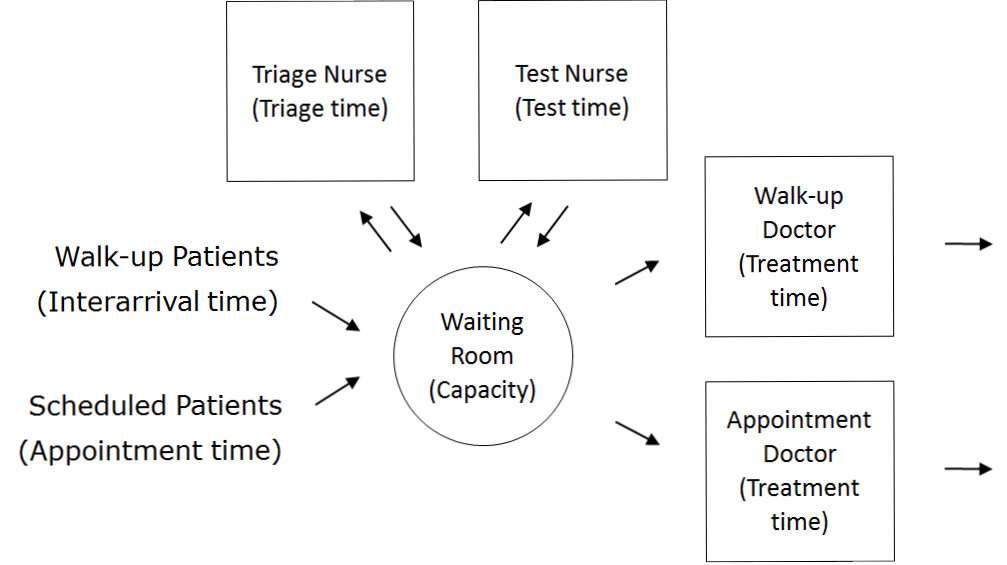
| Patient Logic Flow Diagram | | Doctor Logic Flow Diagram |
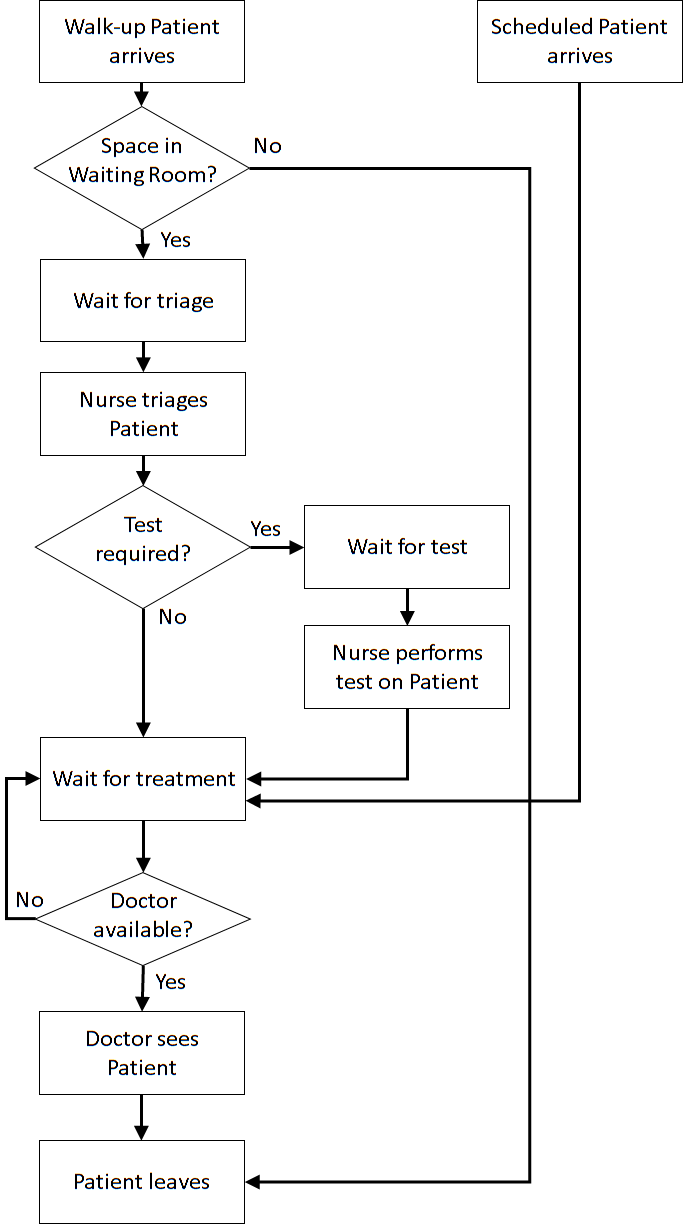 | | 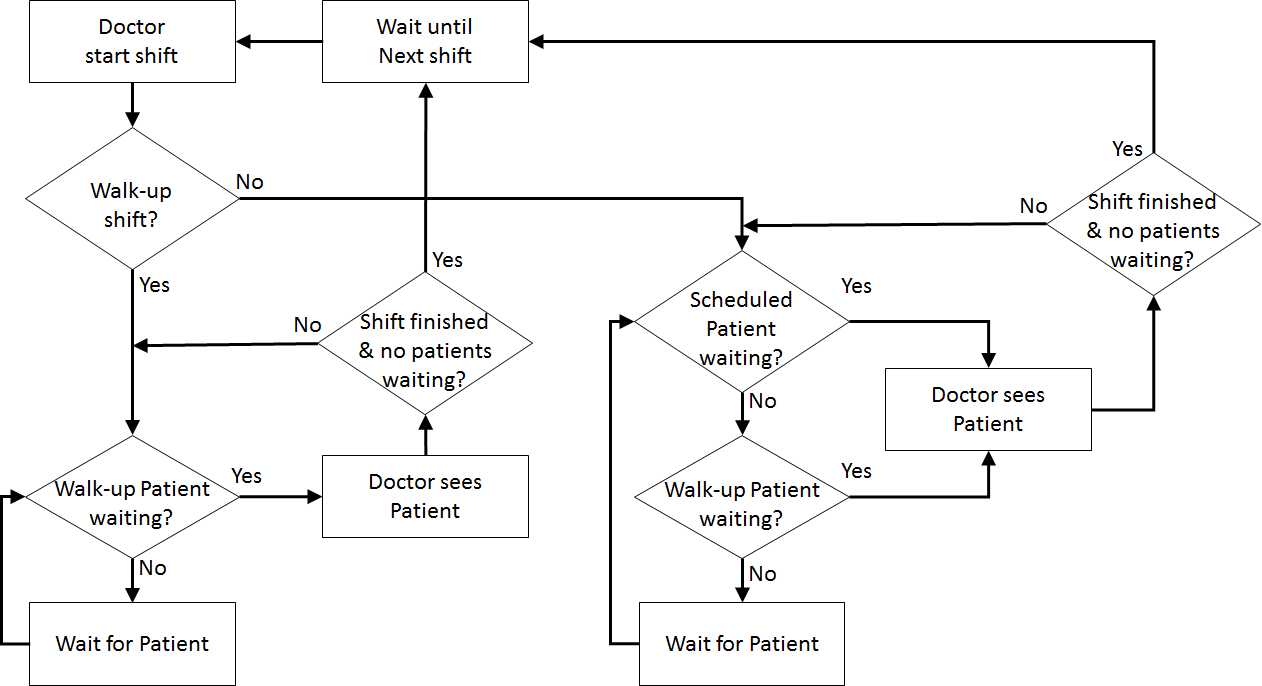 |
| Nurse Logic Flow Diagrams |
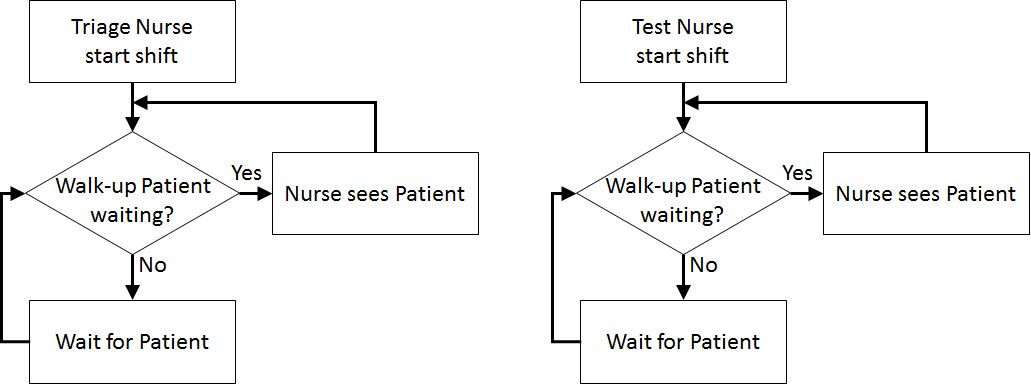 |
Activity Cycle Diagram
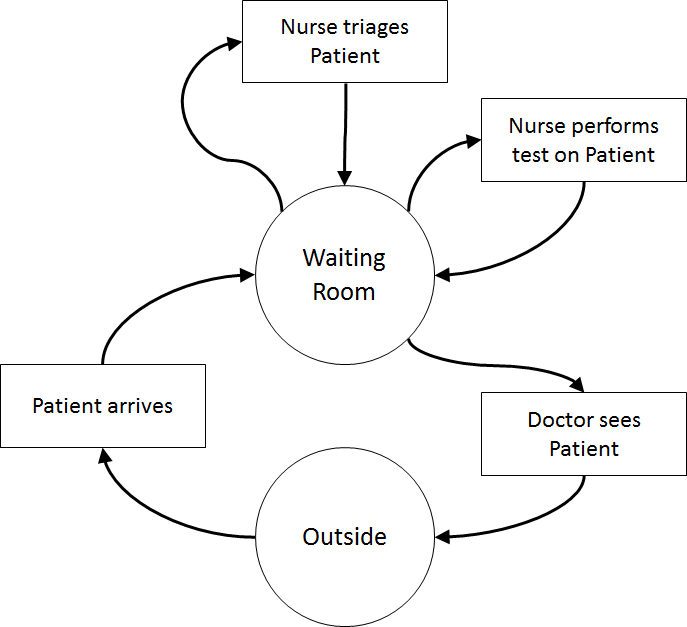 Once the content has been established (note this is usually an iterative process) we can identify the inputs:
Once the content has been established (note this is usually an iterative process) we can identify the inputs:
- doctor roster, appointment times, interarrival times, triage times, test times, treatment times;
and outputs:
- doctor utilisation, waiting times for triage, testing, and treatment (i.e., Patient arrives to Nurse triages Patient, Nurse triages Patient to Nurse performs test on Patient, Nurse performs test on Patient to Doctor sees Patient, Nurse triages Patient to Doctor sees Patient, Patient arrives to Doctor sees Patient), total clinic time (Patient arrives to Outside), number in waiting room.
Assumptions are used to define stochasticity (e.g., Exponential interarrivals, Triangular treatment times) and the simplifications keep the system simple (e.g., nurses on all day for triage and testing, and treatment, no registration, no prioritisation).
Return to top
Computational Model
Start with the Extended Health Clinic JaamSim model.
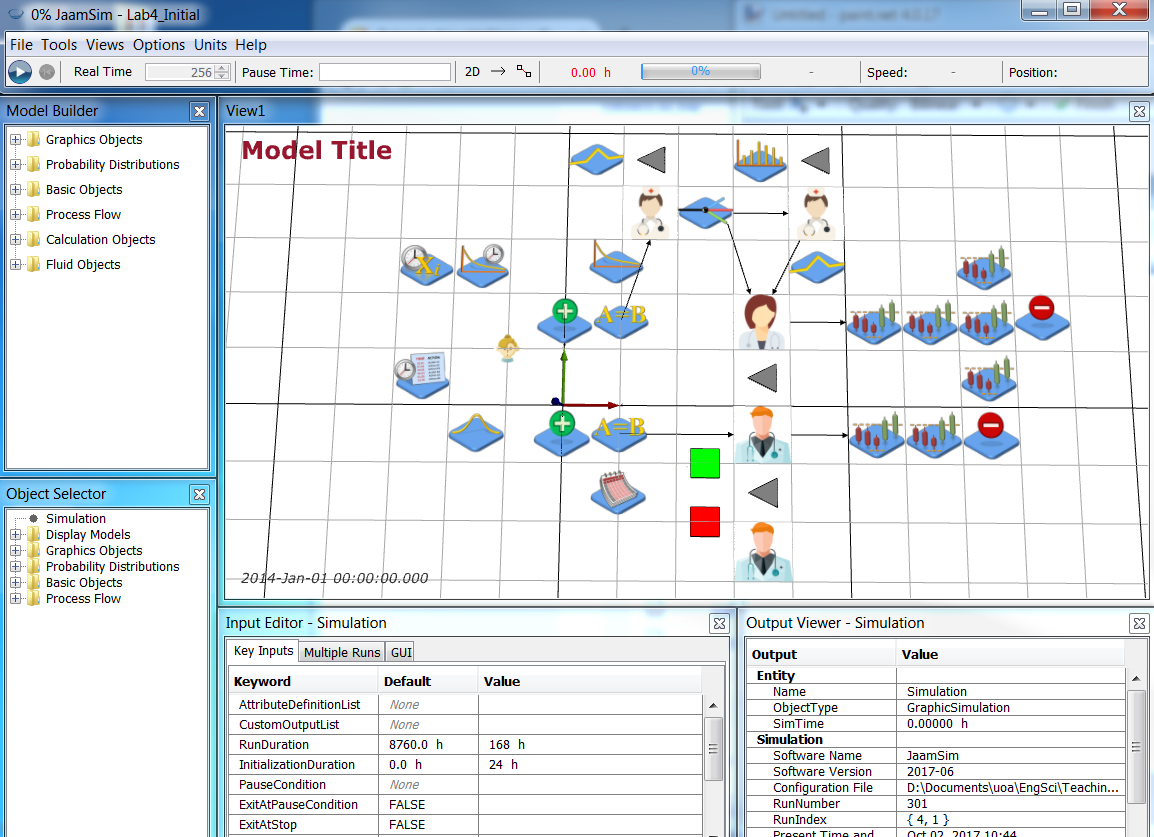 To enable the doctors to switch roles, the Server objects (that queue entities and process them one by one) need to be separated into the four distinct parts that implements a Server, namely: Resource, Seize, EntityDelay, Release.
The Resource object is used to represent a pool of identical equipment or processor units (in this case doctors). Resources can be seized and released by Seize and Release objects.
The Server object can then be modelled as a Resource with capacity one, a Seize that seizes that resource, an EntityDelay to represent the processing time, and a Release to release the resource.
However, in this example, the EntityDelay is replaced with a Server object. Strictly speaking, this is not necessary, but the Server will perform the same task as an EntityDelay since we will use the Seize and Release to control access to the Server (i.e., it won't have any queue) and it will serves the same purpose of delaying the entities for a period of time). Also, the Servers we will use have already been created (we will "repurpose them") and have useful outputs that are automatically generated, such as utilisation.
Before the new objects are created some modifications need to be made to the old model. Doctor2WalkUp, AppointmentThreshold, and WalkUpThreshold should be deleted. Note, do not delete the WalkupQueue and AppointmentQueue, we will also repurpose them later (for the Seize objects for Walk-up and Appointment patients respectively).
To enable the doctors to switch roles, the Server objects (that queue entities and process them one by one) need to be separated into the four distinct parts that implements a Server, namely: Resource, Seize, EntityDelay, Release.
The Resource object is used to represent a pool of identical equipment or processor units (in this case doctors). Resources can be seized and released by Seize and Release objects.
The Server object can then be modelled as a Resource with capacity one, a Seize that seizes that resource, an EntityDelay to represent the processing time, and a Release to release the resource.
However, in this example, the EntityDelay is replaced with a Server object. Strictly speaking, this is not necessary, but the Server will perform the same task as an EntityDelay since we will use the Seize and Release to control access to the Server (i.e., it won't have any queue) and it will serves the same purpose of delaying the entities for a period of time). Also, the Servers we will use have already been created (we will "repurpose them") and have useful outputs that are automatically generated, such as utilisation.
Before the new objects are created some modifications need to be made to the old model. Doctor2WalkUp, AppointmentThreshold, and WalkUpThreshold should be deleted. Note, do not delete the WalkupQueue and AppointmentQueue, we will also repurpose them later (for the Seize objects for Walk-up and Appointment patients respectively).
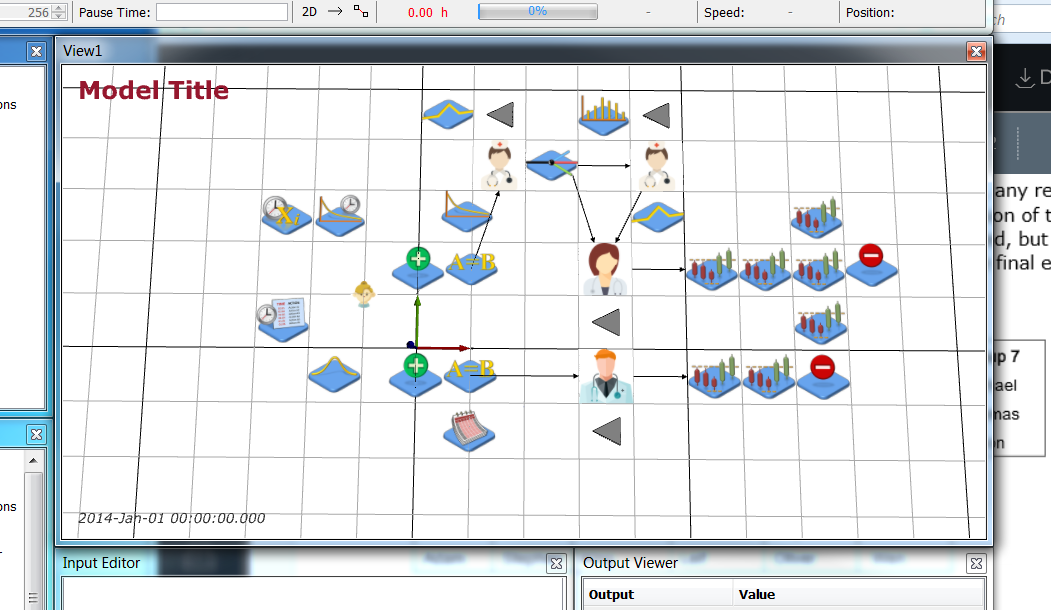 Now rename the Doctor Server to be Doctor1 and Doctor2Appointment to be Doctor2. These Servers represent the two doctors and we will send patients to these Servers depending on what shift they are currently rostered to. First, create two new Queues Doctor1Queue and Doctor2Queue for these doctors. These queues should never be used. Next, create two Release objects (Model Builder > Process Flow > Release) that will release the Resource used by the Server once treatment has ended. Name these Release objects Doctor1Release and Doctor2Release respectively.
Now rename the Doctor Server to be Doctor1 and Doctor2Appointment to be Doctor2. These Servers represent the two doctors and we will send patients to these Servers depending on what shift they are currently rostered to. First, create two new Queues Doctor1Queue and Doctor2Queue for these doctors. These queues should never be used. Next, create two Release objects (Model Builder > Process Flow > Release) that will release the Resource used by the Server once treatment has ended. Name these Release objects Doctor1Release and Doctor2Release respectively.
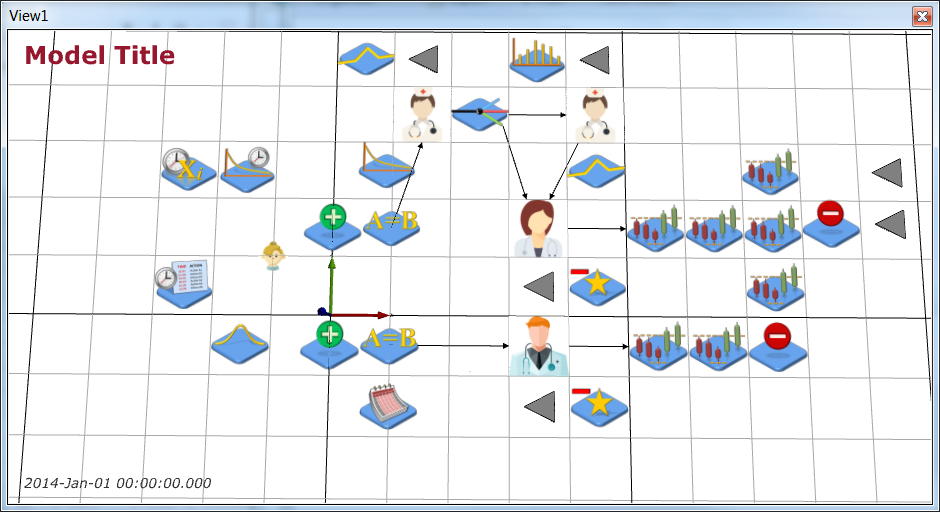 Save your simulation.
Next, we are going to create Resources to represent the (Walk-up and Appointment) shifts and create rosters for the two doctors. Add two Resources (Model Builder > Process Flow > Resource) to your model and name them AppointmentDoctor and WalkupDoctor respectively. Note that these Resources have capacity 1 by default.
Save your simulation.
Next, we are going to create Resources to represent the (Walk-up and Appointment) shifts and create rosters for the two doctors. Add two Resources (Model Builder > Process Flow > Resource) to your model and name them AppointmentDoctor and WalkupDoctor respectively. Note that these Resources have capacity 1 by default.
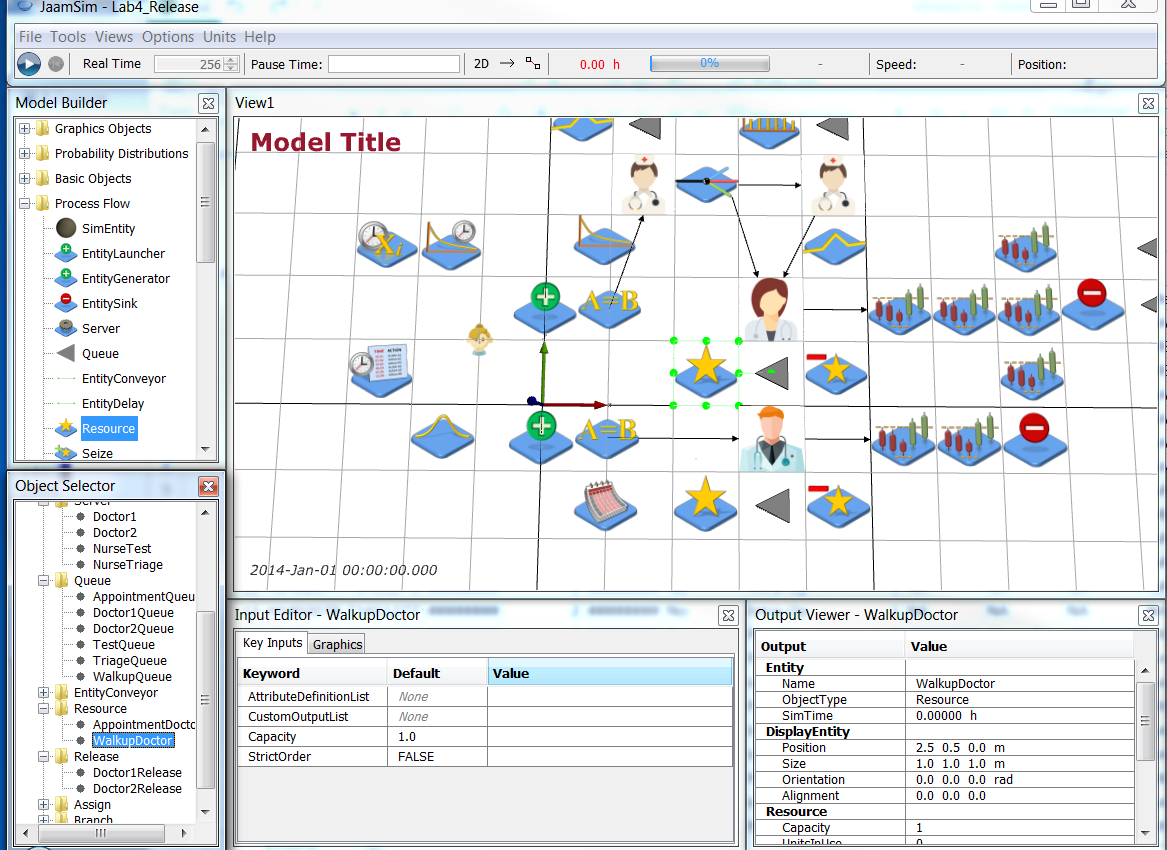 Now add two TimeSeries objects (Model Builder > Basic Objects > TimeSeries) to your model and name them Doctor1Roster and Doctor2Roster respectively. These TimeSeries define if each doctor is working as the Appointment doctor or not. Configure these TimeSeries as follows
Now add two TimeSeries objects (Model Builder > Basic Objects > TimeSeries) to your model and name them Doctor1Roster and Doctor2Roster respectively. These TimeSeries define if each doctor is working as the Appointment doctor or not. Configure these TimeSeries as follows
| Object |
Key Inputs |
| Doctor1Roster |
UnitType = DimensionlessUnit
Value = { 0 h 1 } { 24 h 0 }
CycleTime = 48 h |
| Doctor2Roster |
UnitType = DimensionlessUnit
Value = { 0 h 0 } { 24 h 1 }
CycleTime = 48 h |
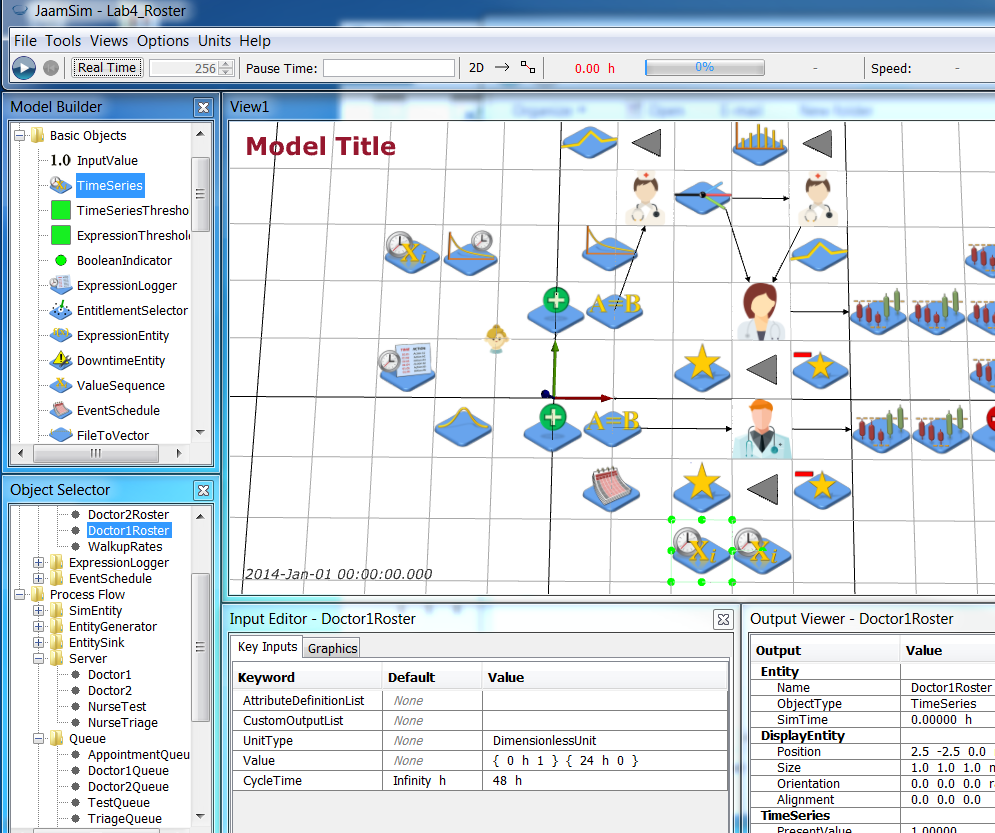 This means that Doctor1 will be the Appointment doctor for the first 24 hrs and Doctor2 will be the Appointment doctor for the next 24 hrs and this 48 hr pattern will repeat (i.e., they will alternate shifts each day).
Now reconfigure the doctor Server objects to use the new Queues, the new rosters, and send patients to the Release components. Also, we are going to generate some custom outputs
This means that Doctor1 will be the Appointment doctor for the first 24 hrs and Doctor2 will be the Appointment doctor for the next 24 hrs and this 48 hr pattern will repeat (i.e., they will alternate shifts each day).
Now reconfigure the doctor Server objects to use the new Queues, the new rosters, and send patients to the Release components. Also, we are going to generate some custom outputs
| Object |
Key Inputs |
| Doctor1 |
CustomOutputList = {DoctorNumber 1} {Queue [Doctor1Queue] } { IsAppointmentDoc [Doctor1Roster].PresentValue }
NextComponent = Doctor1Release
WaitQueue = Doctor1Queue |
| Doctor2 |
CustomOutputList = {DoctorNumber 2} {Queue [Doctor2Queue] } { IsAppointmentDoc [Doctor2Roster].PresentValue }
NextComponent = Doctor2Release
WaitQueue = Doctor2Queue |
Save your simulation.
Now that our doctor Servers are using rosters and sending patients to Release objects we need to Seize the appropriate Resource, send patients to the appropriate doctor, and then Release the Resource after the doctor has treated the patient. Add two Seize objects and call then WalkupSeize and AppointmentSeize respectively.
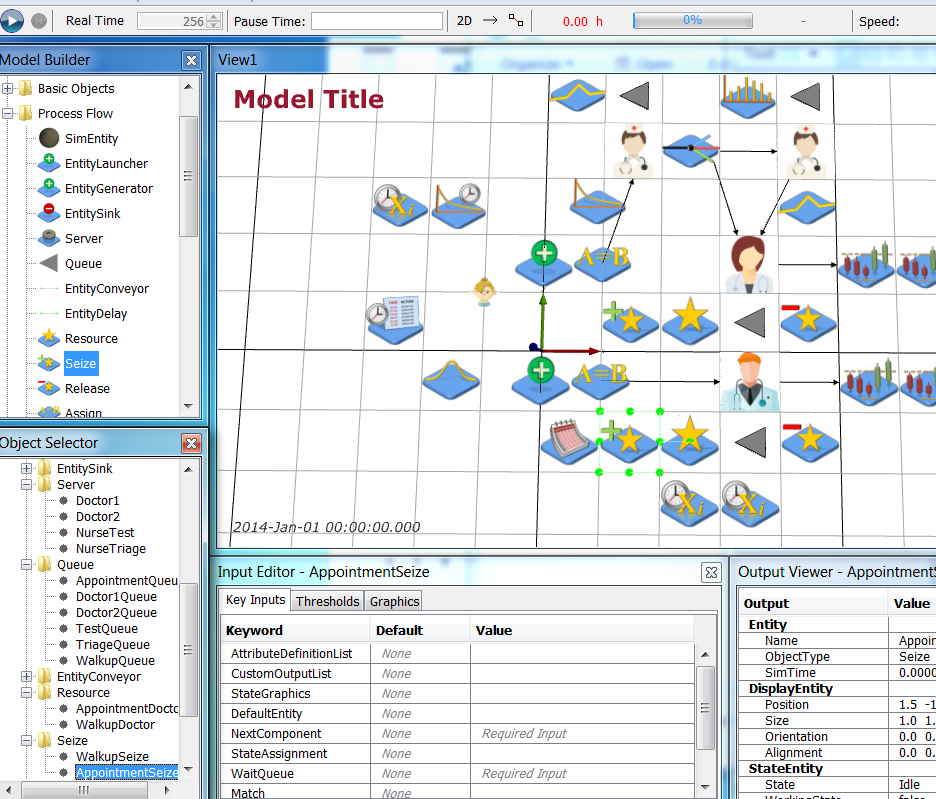 The configuration of the Seize objects is complicated and is where the majority of the logic for the doctors’ roster is implemented.
First, define a DoctorsList attribute on both Seize objects that gives the list of Servers (doctors) available to send patients to
The configuration of the Seize objects is complicated and is where the majority of the logic for the doctors’ roster is implemented.
First, define a DoctorsList attribute on both Seize objects that gives the list of Servers (doctors) available to send patients to
| Object |
Key Inputs |
| WalkupSeize |
AttributeDefinitionList = { DoctorsList '{[Doctor1], [Doctor2]}' } |
| AppointmentSeize |
AttributeDefinitionList = { DoctorsList '{[Doctor1], [Doctor2]}' } |
Next, define a custom output NextDoc that determines which doctor in the DoctorsList to send the patient to. For Appointment patients, i.e., the AppointmentSeize, the DoctorsList is filtered to only contain those for which IsAppointmentDoc > 0 (i.e., they are the Appointment doctor) and choosing the first in the list. This can be done by using the built-in filter function with a "lambda" function that determines if an object should be included. The lambda function takes one input and is defined using two vertical lines to denote the input (in this case x) and an expression in parentheses that defines the return value of the function (in this case whether the doctor Server object is the Appointment doctor. The lambda function expression is
|x|(x.IsAppointmentDoc > 0)
The filter function takes this lambda function and a list of objects (in this case the DoctorsList of the Seize object), applies the function to each object in the list and then includes or excludes it from the resulting list (returned from the filter function accordingly). The NextDoc definition is
| Object |
Key Inputs |
| AppointmentSeize |
CustomOutputList = { NextDoc 'AppointmentDoc = filter(|x|(x.IsAppointmentDoc > 0), this.DoctorsList); AppointmentDoc(1)' } |
This expression creates the AppointmentDoc list by looking at each x in this.DoctorsList (i.e., the DoctorsList for the AppointmentSeize), and including them in the AppointmentDoc list if their IsAppointmentDoc custom output is > 0 (set by the rosters). Once the list has been created, then NextDoc is set to the first object in the list.
For Walk-Up patients the logic is more complicated. In order to use both doctors in the roster in the right order, i.e., Walk-Up doctor first then Appointment doctor if free, we sort the DoctorsList using the built-in sort function that takes as input a lambda function (similar to the lambda function for filter), but with two inputs. This lambda function put the objects in order x then y is the function returns true and y then x if function return false. The lambda function in this model looks at the the doctor Servers in DoctorsList and puts the Appointment doctor last (by putting y last if y is the Appointment doctor or x last if y is not).
|x, y|(y.IsAppointmentDoc > x.IsAppointmentDoc)
The sort function then applies this lambda function to sort the DoctorsList to create a WalkupDocs list
WalkupDocs = sort(|x, y|(y.IsAppointmentDoc > x.IsAppointmentDoc), this.DoctorsList)
The WalkupDocs list is then filtered to create a list of AvailableDocs (similar to the filtering for the AppointmentSeize object) that only includes those doctor Server objects which aren’t treating patients or that have patients waiting
AvailableDocs = filter(|x|(x.NumberInProgress + x.Queue.QueueLength == 0), WalkupDocs)
Note that x.Queue.QueueLength should always be zero, but JaamSim does queue patients at the doctor Servers (for zero time) before moving them into processing. Depending on the order conditional calculations are performed internally x.NumberInProgress may be 0 and x.Queue.QueueLength may be 1, hence the expression used.
Finally, the first available doctor is selected for NextDoc, but WalkupSeize is sometimes checked when both doctors are treating patents, so AvailableDocs may be empty. We use a conditional statement to assign the first doctor in DoctorsList if the AvailableDocs list is empty (although the Seize will not be used by a PatientEntity as no doctor is available - so the WalkupDoctor Resource is currently utilised)
size(AvailableDocs) > 0 ? AvailableDocs(1) : this.DoctorsList(1)
The final expression in its entirety is
| Object |
Key Inputs |
| WalkupSeize |
CustomOutputList = { NextDoc 'WalkupDocs = sort(|x, y|(y.IsAppointmentDoc > x.IsAppointmentDoc), this.DoctorsList); AvailableDocs = filter(|x|(x.NumberInProgress + x.Queue.QueueLength == 0), WalkupDocs); size(AvailableDocs) > 0 ? AvailableDocs(1) : this.DoctorsList(1)' } |
Now we need to define which Resource gets seized and which Queue is used if no Resource is available
| Object |
Key Inputs |
| WalkupSeize |
WaitQueue = WalkupQueue
ResourceList = AppointmentDoctor WalkupDoctor
NumberOfUnits = { this.NextDoc.IsAppointmentDoc } { '1 - this.NextDoc.IsAppointmentDoc' } |
| AppointmentSeize |
WaitQueue = AppointmentQueue
ResourceList = AppointmentDoctor WalkupDoctor
NumberOfUnits = { 1 } { 0 } |
From the Seize objects patients go to Assign and Branch objects to send patients to the right doctor. We will work backwards from the doctor Servers.
First, add a Branch object and call it! BranchDoctor. Configure it to send patients to either Doctor1 or Doctor2 depending on which doctor they were assigned to
| Object |
Key Inputs |
| BranchDoctor |
NextComponentList = Doctor1 Doctor2
Choice = this.obj.Doctor |
Next, add two Assign objects and call them AssignWalkupDoctor and AssignAppointmentDoctor respectively. Both Assign objects send the patients to BranchDoctor next and use outputs from the Seize objects to define which doctor to go to and which type of doctor was seized. You also need to add the Doctor attribute to your PatientEntity so patients can keep track of the doctor they are assigned to for treatment and the doctor type Resource they seized.
| Object |
Key Inputs |
| AssignWalkupDoctor |
AttributeAssignmentList = { 'this.obj.Doctor = [WalkupSeize].NextDoc.DoctorNumber' } { 'this.obj.SeizedDocs = [WalkupSeize].SeizedUnits' }
NextComponent = BranchDoctor |
| AssignAppointmentDoctor |
AttributeAssignmentList = { 'this.obj.Doctor = [AppointmentSeize].NextDoc.DoctorNumber' } { 'this.obj.SeizedDocs = [AppointmentSeize].SeizedUnits' }
NextComponent = BranchDoctor |
| PatientEntity |
AttributeDefinitionList = { PatientType "" } { Test 0 } { Doctor 0 } { SeizedDocs '{ 0, 0 }' } |
We also need to use a Branch object to route the patients to the appropriate "leaving" conveyor. Add a Branch object named BranchLeave and configure it to route patients to leave as a Walk-Up patient or Appointment patient respectively.
| Object |
Key Inputs |
| BranchLeave |
NextComponentList = TreatToLeave TreatToLeave2
Choice = 'this.obj.PatientType == "Walkup" ? 1 : 2' |
Save your simulation.
Next we will make sure that the patient flow is correct for the new Seize-Release structure and that Resources are being released properly.
| Object |
Key Inputs |
| TriageToDoctor |
NextComponent = WalkupSeize |
| TestToDoctor |
NextComponent = WalkupSeize |
| ArriveToTreat2 |
NextComponent = AppointmentSeize |
| WalkupSeize |
NextComponent = AssignWalkupDoctor |
| AppointmentSeize |
NextComponent = AssignAppointmentDoctor |
| Doctor1Release |
Resource = AppointmentDoctor WalkupDoctor
NumberOfUnits = { this.obj.SeizedDocs(1) } { this.obj.SeizedDocs(2) }
NextComponent = BranchLeave |
| Doctor2Release |
Resource = AppointmentDoctor WalkupDoctor
NumberOfUnits = { this.obj.SeizedDocs(1) } { this.obj.SeizedDocs(2) }
NextComponent = BranchLeave |
You may like to reorganise your layout at this point! Note to get labels on objects, select the object, right click and choose Show Label. You can then select the label and (holding Ctrl down) move it relative to the object to make your layout diagram "look nice".
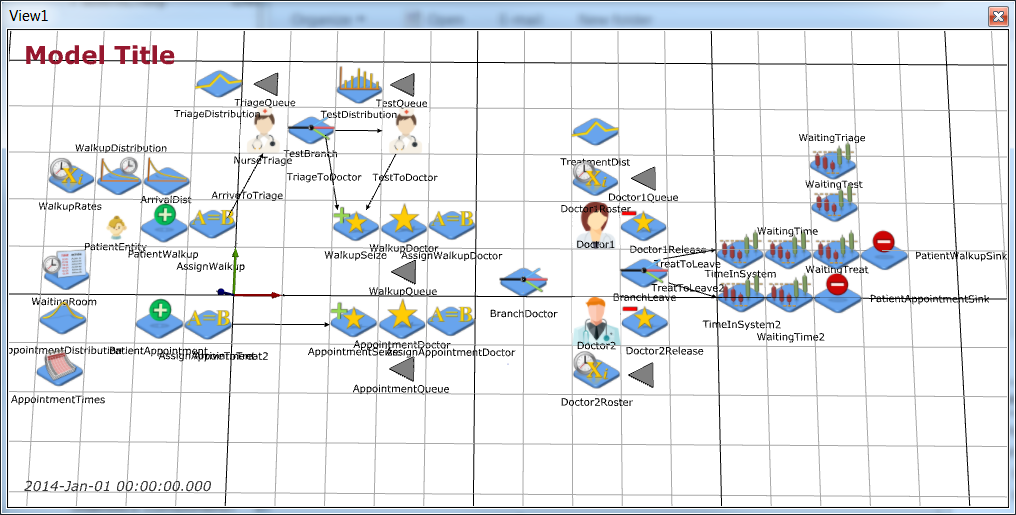 Return to top
Return to top
Results
Note that JaamSim has probably complained about your RunOutputList as we have changed a lot of components in our model and this value (Object Selector > Simulation > Key Inputs > RunOutputList) may be empty at this point. Edit the Simulation Key Inputs to get the outputs we want, the only changes are to change [Doctor].Utilisation to [Doctor1].Utilisation and '[Doctor2Appointment].Utilisation + [Doctor2Walkup].Utilisation' to [Doctor2].Utilisation.
| Object |
Key Inputs |
| Simulation |
UnitTypeList = DimensionlessUnit TimeUnit TimeUnit TimeUnit TimeUnit TimeUnit DimensionlessUnit DimensionlessUnit TimeUnit TimeUnit DimensionlessUnit DimensionlessUnit
RunOutputList = { [Simulation].RunIndex(1) } { [WaitingTriage].SampleAverage } { [WaitingTest].SampleAverage } { [WaitingTreat].SampleAverage } { [WaitingTime].SampleAverage } { [TimeInSystem].SampleAverage } { '[TriageQueue].QueueLengthAverage + [TestQueue].QueueLengthAverage + [WalkupQueue].QueueLengthAverage' }{ [Doctor1].Utilisation } { [WaitingTime2].SampleAverage } { [TimeInSystem2].SampleAverage } { [AppointmentQueue].QueueLengthAverage } { [Doctor2].Utilisation } |
Save your simulation.
As in the Extended Health Clinic case study, perform 100 runs of this simulation each 168 hours long and with 24 hours warm up to examine the effect of the changes to the health clinic and observe the difference in average time in system and queue length for the walk up and appointment patients, and the difference in utilisation of the walk up only doctor and the appointment and walk up doctor. No changes to the Simulation object's Key Inputs other than those described earlier in this case study are needed. The Simulation runs are as follows:
Run your simulation and modify Lab4Analysis.R to use your .dat file. Your results should be as below.
ConfLower Mean ConfUpper
WalkUp.WaitingTriage 0.063607 0.066832 0.070057
WalkUp.WaitingTest 0.001793 0.001953 0.002113
WalkUp.WaitingTreat 0.127544 0.135612 0.143679
WalkUp.WaitingTime 0.194155 0.204397 0.214640
WalkUp.TimeInSystem 0.709928 0.720624 0.731319
Num.WalkUps.Waiting 0.469415 0.497684 0.525952
Doctor1.Utilisation 0.641166 0.645107 0.649047
Appointment.WaitingTime 0.194093 0.200859 0.207624
Appointment.TimeInSystem 0.476982 0.484046 0.491111
Appointment.Queue 0.572599 0.593162 0.613724
Doctor2.Utilisation 0.692690 0.696761 0.700831
> t.test(Lab4scen$WalkUp.WaitingTime, Lab4scen$Appointment.WaitingTime)
Welch Two Sample t-test
data: Lab4scen$WalkUp.WaitingTime and Lab4scen$Appointment.WaitingTime
t = 0.572, df = 171.57, p-value = 0.5681
alternative hypothesis: true difference in means is not equal to 0
95 percent confidence interval:
-0.008672611 0.015749916
sample estimates:
mean of x mean of y
0.2043972 0.2008585
|
> t.test(Lab4scen$WalkUp.TimeInSystem, Lab4scen$Appointment.TimeInSystem)
Welch Two Sample t-test
data: Lab4scen$WalkUp.TimeInSystem and Lab4scen$Appointment.TimeInSystem
t = 36.621, df = 171.57, p-value < 2.2e-16
alternative hypothesis: true difference in means is not equal to 0
95 percent confidence interval:
0.2238259 0.2493289
sample estimates:
mean of x mean of y
0.7206239 0.4840465
|
> t.test(Lab4scen$Num.WalkUps.Waiting, Lab4scen$Appointment.Queue)
Welch Two Sample t-test
data: Lab4scen$Num.WalkUps.Waiting and Lab4scen$Appointment.Queue
t = -5.4196, df = 180.85, p-value = 1.889e-07
alternative hypothesis: true difference in means is not equal to 0
95 percent confidence interval:
-0.13023947 -0.06071654
sample estimates:
mean of x mean of y
0.4976837 0.5931617
|
> t.test(Lab4scen$Doctor1.Utilisation, Lab4scen$Doctor2.Utilisation)
Welch Two Sample t-test
data: Lab4scen$Doctor1.Utilisation and Lab4scen$Doctor2.Utilisation
t = -18.092, df = 197.79, p-value < 2.2e-16
alternative hypothesis: true difference in means is not equal to 0
95 percent confidence interval:
-0.05728439 -0.04602373
sample estimates:
mean of x mean of y
0.6451066 0.6967607
|
What do these results tell you?
The t-tests from the Extended Health Clinic are as follows
> t.test(Lab3scen$WalkUp.WaitingTime, Lab3scen$Appointment.WaitingTime)
Welch Two Sample t-test
data: Lab3scen$WalkUp.WaitingTime and Lab3scen$Appointment.WaitingTime
t = 15.837, df = 107.4, p-value < 2.2e-16
alternative hypothesis: true difference in means is not equal to 0
95 percent confidence interval:
0.1069441 0.1375463
sample estimates:
mean of x mean of y
0.2509337 0.1286884
|
> t.test(Lab3scen$WalkUp.TimeInSystem, Lab3scen$Appointment.TimeInSystem)
Welch Two Sample t-test
data: Lab3scen$WalkUp.TimeInSystem and Lab3scen$Appointment.TimeInSystem
t = 44.681, df = 109.6, p-value < 2.2e-16
alternative hypothesis: true difference in means is not equal to 0
95 percent confidence interval:
0.3385983 0.3700297
sample estimates:
mean of x mean of y
0.7660578 0.4117439
|
> t.test(Lab3scen$Num.WalkUps.Waiting, Lab3scen$Appointment.Queue)
Welch Two Sample t-test
data: Lab3scen$Num.WalkUps.Waiting and Lab3scen$Appointment.Queue
t = 11.073, df = 110.3, p-value < 2.2e-16
alternative hypothesis: true difference in means is not equal to 0
95 percent confidence interval:
0.1892095 0.2716937
sample estimates:
mean of x mean of y
0.6122041 0.3817525
|
> t.test(Lab3scen$Doctor.Utilisation, Lab3scen$Doctor2.Utilisation)
Welch Two Sample t-test
data: Lab3scen$Doctor.Utilisation and Lab3scen$Doctor2.Utilisation
t = -113.6, df = 159.57, p-value < 2.2e-16
alternative hypothesis: true difference in means is not equal to 0
95 percent confidence interval:
-0.3491496 -0.3372173
sample estimates:
mean of x mean of y
0.4993517 0.8425352
|
It appears that the Appointment patients are a little "worse off" under the rostering system, although the policy for seeing patients has not changed. What has happened?
We have implemented the Appointment doctor helping out (with rosters determining who that doctor is), but we have not prioritised Appointment patients for the Appointment doctor. Since the AppointmentSeize only utilises the Appointment doctor, we can prioritise this Seize’s Queue over the WalkupSeize’s Queue. Note that lower Priority means a Queue will be served first…
Save your simulation.
Run your simulation and modify Lab4Analysis.R to use your .dat file. Your t-test results are now
> t.test(Lab4scen$WalkUp.WaitingTime, Lab4scen$Appointment.WaitingTime)
Welch Two Sample t-test
data: Lab4scen$WalkUp.WaitingTime and Lab4scen$Appointment.WaitingTime
t = 15.715, df = 107.83, p-value < 2.2e-16
alternative hypothesis: true difference in means is not equal to 0
95 percent confidence interval:
0.1064297 0.1371549
sample estimates:
mean of x mean of y
0.2520324 0.1302401
|
> t.test(Lab4scen$WalkUp.TimeInSystem, Lab4scen$Appointment.TimeInSystem)
Welch Two Sample t-test
data: Lab4scen$WalkUp.TimeInSystem and Lab4scen$Appointment.TimeInSystem
t = 44.444, df = 110.04, p-value < 2.2e-16
alternative hypothesis: true difference in means is not equal to 0
95 percent confidence interval:
0.3384345 0.3700247
sample estimates:
mean of x mean of y
0.7679160 0.4136864
|
> t.test(Lab4scen$Num.WalkUps.Waiting, Lab4scen$Appointment.Queue)
Welch Two Sample t-test
data: Lab4scen$Num.WalkUps.Waiting and Lab4scen$Appointment.Queue
t = 11.03, df = 110.76, p-value < 2.2e-16
alternative hypothesis: true difference in means is not equal to 0
95 percent confidence interval:
0.1888664 0.2715930
sample estimates:
mean of x mean of y
0.6140961 0.3838663
|
> t.test(Lab4scen$Doctor1.Utilisation, Lab4scen$Doctor2.Utilisation)
Welch Two Sample t-test
data: Lab4scen$Doctor1.Utilisation and Lab4scen$Doctor2.Utilisation
t = -16.645, df = 197.12, p-value < 2.2e-16
alternative hypothesis: true difference in means is not equal to 0
95 percent confidence interval:
-0.05411466 -0.04265012
sample estimates:
mean of x mean of y
0.6467522 0.6951346
|
Other than doctor utilisation (which should be different), the values are very close to those from the Extended Health Clinic!
Note that Doctor 2 is more utilised than Doctor 1 which seems strange, why is the utilisation not equal? (Hint Think carefully about how long you are simulating.) How could you verify the alternating days roster?
Return to top
Conclusions
In this case study, you extended the Extended Health Clinic model to use a roster for the doctors in order to try and balance workload. You investigated the effect of this change to the quality of care of the patients (their experience was the same as before) as well as the workload of the doctors. The workload seems fairly (but not exactly) balanced over 168 hrs.
Return to top
<--
-->
<--
-->
|*FORM FIELD ProblemDescription*|ProblemDescription|This case study extends the Extended Health Clinic model. The extension adds a roster for two doctors that assigns them to the shifts involving:
- only seeing Walk-up patients;
- seeing Appointment patients and Walk-up patients if free;
so that the workload of the two doctors is balanced.
The goal of this simulation study is to analyse the utilisation of the two doctors while ensuring that the patients’ quality of care remains consistent, i.e., still need to monitor the patient waiting times, time patients spend at the clinic, and how crowded the waiting room is. This analysis will include a comparison of the doctors’ utilisation.
|
|*FORM FIELD ProblemFormulation*|ProblemFormulation|In order to formulate a simulation model we specify the following components:
- Background – problem description
- Objectives of the study
- Expected benefits
- The CM: inputs, outputs, content, assumptions, simplifications’
- Experiments to run
Components 1 (Background – problem description) and 2 (Objectives of the study) are given in the Problem Description section (see paragraph describing the goal of the simulation study to identify study objectives).
The Expected benefits (component 3) are a virtual environment for evaluating the doctors’ roster as well as monitoring patient waiting times, total time patients spend in the clinic, and the number of patients waiting for treatment. This environment can be used to experiment with changes to the roster, including a comparison of effects on the doctors’ utilisation.
The CM content is specified using the following components:
- Component List
- Process flow diagram
- Logic flow diagram
- Activity cycle diagram
Component List
The components of the Extended Health Clinic model are:
- Walk-up patients with their (inter)arrival times
- Scheduled patients with their appointment times
- Triage nurses with their triage times
- Test nurses with their testing times
- Doctors with their roster and treatment times
- Waiting room with its capacity
Process Flow Diagram
Note that the process flow diagram stays the same as the only change will be which doctor is the Walk-up Doctor and which doctor is the Appointment Doctor.

| Patient Logic Flow Diagram | | Doctor Logic Flow Diagram |
 | |  |
| Nurse Logic Flow Diagrams |
 |
Activity Cycle Diagram
 Once the content has been established (note this is usually an iterative process) we can identify the inputs:
Once the content has been established (note this is usually an iterative process) we can identify the inputs:
- doctor roster, appointment times, interarrival times, triage times, test times, treatment times;
and outputs:
- doctor utilisation, waiting times for triage, testing, and treatment (i.e., Patient arrives to Nurse triages Patient, Nurse triages Patient to Nurse performs test on Patient, Nurse performs test on Patient to Doctor sees Patient, Nurse triages Patient to Doctor sees Patient, Patient arrives to Doctor sees Patient), total clinic time (Patient arrives to Outside), number in waiting room.
Assumptions are used to define stochasticity (e.g., Exponential interarrivals, Triangular treatment times) and the simplifications keep the system simple (e.g., nurses on all day for triage and testing, and treatment, no registration, no prioritisation).
|
| FORM FIELD ComputationalModel |
ComputationalModel |
The computational model... |
| FORM FIELD Results |
Results |
The results... |
| FORM FIELD Conclusions |
Conclusions |
In conclusion... |
| FORM FIELD ExtraForExperts |
ExtraForExperts |
| FORM FIELD StudentTasks |
StudentTasks |
| META FILEATTACHMENT |
attachment="ProcessFlowDiagram.png" attr="h" comment="" date="1507262838" name="ProcessFlowDiagram.png" path="ProcessFlowDiagram.png" size="103327" stream="ProcessFlowDiagram.png" tmpFilename="/var/tmp/CGItemp9321" user="MichaelOSullivan" version="1" |
| META FILEATTACHMENT |
attachment="ActivityCycleDiagram.png" attr="h" comment="" date="1507262848" name="ActivityCycleDiagram.png" path="ActivityCycleDiagram.png" size="15772" stream="ActivityCycleDiagram.png" tmpFilename="/var/tmp/CGItemp9214" user="MichaelOSullivan" version="1" |
| META FILEATTACHMENT |
attachment="NurseLogicFlowDiagram.png" attr="h" comment="" date="1507262862" name="NurseLogicFlowDiagram.png" path="NurseLogicFlowDiagram.png" size="9216" stream="NurseLogicFlowDiagram.png" tmpFilename="/var/tmp/CGItemp9233" user="MichaelOSullivan" version="1" |
| META FILEATTACHMENT |
attachment="PatientLogicFlowDiagram.png" attr="h" comment="" date="1507262871" name="PatientLogicFlowDiagram.png" path="PatientLogicFlowDiagram.png" size="23538" stream="PatientLogicFlowDiagram.png" tmpFilename="/var/tmp/CGItemp9215" user="MichaelOSullivan" version="1" |
| META FILEATTACHMENT |
attachment="DoctorLogicFlowDiagram.png" attr="" comment="" date="1507262881" name="DoctorLogicFlowDiagram.png" path="DoctorLogicFlowDiagram.png" size="23587" stream="DoctorLogicFlowDiagram.png" tmpFilename="/var/tmp/CGItemp9188" user="MichaelOSullivan" version="1" |
|

